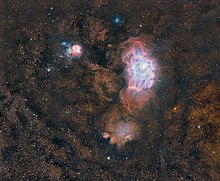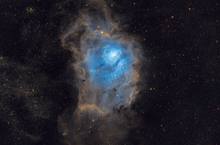Lagoon Nebula
| Emission nebula | |
|---|---|
| H II region | |
 M8, the Lagoon Nebula | |
| Observation data:J2000epoch | |
| Right ascension | 18h03m37s[1] |
| Declination | −24° 23′ 12″[1] |
| Distance | 4,100[2]ly(1,250pc) |
| Apparent magnitude(V) | 4.6[3] |
| Apparent dimensions (V) | 90 × 40arcmins[3] |
| Constellation | Sagittarius |
| Physical characteristics | |
| Radius | 55 × 20 ly |
| Designations | Sharpless25,RCW146, Gum 72 M8 contains: NGC6523, NGC 6530,[1] Hourglass nebula[4] |
TheLagoon Nebula(catalogued asMessier 8orM8,NGC 6523,Sharpless 25,RCW 146,andGum 72) is a giantinterstellar cloudin theconstellationSagittarius.It is classified as anemission nebulaand has anH II region.
The Lagoon Nebula was discovered byGiovanni Hodiernabefore 1654[5]and is one of only two star-formingnebulaefaintly visible to the eye from mid-northern latitudes. Seen withbinoculars,it appears as a distinct cloud-like patch with a definite core. Within the nebula is theopen clusterNGC 6530.[6]
Characteristics
[edit]

The Lagoon Nebula is estimated to be between 4,000–6,000light-yearsaway from theEarth.In the sky of Earth, it spans 90' by 40', which translates to an actual dimension of 110 by 50 light years. Like many nebulae, it appears pink in time-exposure color photos but is gray to the eye peering throughbinocularsor atelescope,humanvisionhaving poor color sensitivity at low light levels. The nebula contains a number ofBok globules(dark, collapsing clouds of protostellar material), the most prominent of which have been catalogued byE. E. Barnardas B88, B89 and B296. It also includes a funnel-like ortornado-like structure caused by a hotO-type starthat emanatesultraviolet light,heating and ionizing gases on the surface of the nebula. The Lagoon Nebula also contains at its centre a structure known as the Hourglass Nebula (so named byJohn Herschel), which should not be confused with the better knownEngraved Hourglass Nebulain the constellation ofMusca.In 2006, fourHerbig–Haro objectswere detected within the Hourglass, providing direct evidence of activestar formationby accretion within it.[2]
See also
[edit]References
[edit]- ^abc"M 8".SIMBAD.Centre de données astronomiques de Strasbourg.Retrieved2006-11-15.
- ^abArias, J. I.; Barbá, R. H.; Maíz Apellániz, J.;Morrell, N. I.;Rubio, M. (2006). "The infrared Hourglass cluster in M8".Monthly Notices of the Royal Astronomical Society.366(3): 739–757.arXiv:astro-ph/0506552.Bibcode:2006MNRAS.366..739A.doi:10.1111/j.1365-2966.2005.09829.x.S2CID13907667.
- ^abStoyan, Ronald (2008).Atlas of the Messier Objects: Highlights of the Deep Sky.Cambridge University Press. p. 88.ISBN978-0-521-89554-5.
- ^"SIMBAD Astronomical Database".Results for Hourglass Nebula.Retrieved2006-12-22.
- ^Kronberg, Guy McArthur, Hartmut Frommert, Christine."Messier Object 8".messier.seds.org.Retrieved11 April2018.
{{cite web}}:CS1 maint: multiple names: authors list (link) - ^N. F. H. Tothill; Marc Gagné; B. Stecklum; M. A. Kenworthy (2008). "The Lagoon Nebula and its Vicinity". In Bo Reipurth (ed.).Handbook of Star-Forming Regions: Volume 2 The Southern Sky.Astronomical Society of the Pacific. p. 53.ISBN978-1-58381-671-4.
External links
[edit]- Breaking Waves in the Stellar Lagoon—ESA/HubblePhoto Release
- Messier 8, SEDS Messier pages
- NightSkyInfo.com – M8, the Lagoon Nebula
- Messier 8, Pete's Astrophotography GalleryArchived2008-11-20 at theWayback Machine
- Messier 8, Lagoon Nebula, Map
- Astronomy Picture of the Day (APOD): Lagoon Nebula
- APOD: 2005 August 3 - The Busy Center of the Lagoon Nebula
- The Scale of the Universe(Astronomy Picture of the Day2012 March 12)
- The Lagoon Nebula onWikiSky:DSS2,SDSS,GALEX,IRAS,Hydrogen α,X-Ray,Astrophoto,Sky Map,Articles and images
- Lagoon Nebula (M8) on Constellation Guide
- 7/30/2015 Photo releaseHubble Space Telescope
- Lagoon Nebula on Instagram

